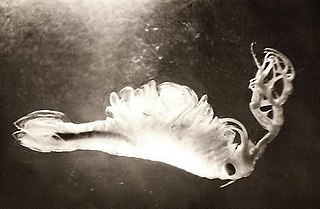
Anaspididae is a family of freshwater crustacean that is endemic to Tasmania, Australia. The family contains 3 genera and 5 species. This group of crustaceans are considered living fossils. They are commonly and collectively known as the Tasmanian anaspid crustaceans. Anaspidids have stalked eyes, long antennae and antennules, and a slender body with no carapace. The two species of Allanaspides and the single species of Paranaspides are all listed as vulnerable on the IUCN Red List.
Allocrangonyx is a genus of troglobitic amphipod crustaceans from the South Central United States. The two species are both listed as vulnerable on the IUCN Red List. The animals are blind and unpigmented. During the male's development, the outer ramus of the third uropod differentiates into secondary segments and grows to a length greater than the animal's body length.

Branchinecta is a genus of crustacean in family Branchinectidae. It includes around 50 species, found on all continents except Africa and Australia. Branchinecta gigas, the giant fairy shrimp, is the largest species in the order, with a length of up to 10 centimetres (4 in), and Branchinecta brushi lives at the highest altitude of any crustacean, at 5,930 metres (19,460 ft), a record it shares with the copepod Boeckella palustris. A new genus, Archaebranchinecta was established in 2011 for two species previously placed in Branchinecta.
Branchinella alachua is a species of crustacean in the family Thamnocephalidae. It was described in 1953 by Ralph W. Dexter based on material collected in 1947 by I. J. Cantrall; 11 male individuals of the new species were discovered among Cantrall's collection of Streptocephalus seali. B. alachua is only known from the type locality, a temporary pool in Alachua County, Florida, from which its specific epithet derives. It is listed as an endangered species on the IUCN Red List.

Branchinella is a genus of crustaceans in the family Thamnocephalidae. This fairy shrimp genus is found across many parts of the world, but especially western Australia and southern Africa.
Branchinella apophysata is a species of crustacean in the family Thamnocephalidae. It is endemic to Australia, where it is known only from its type locality, a shallow pool on Mount Margaret, near Laverton, Western Australia. It is most closely related to other Australian species, including B. affinis, B. denticulata, B. latzi, B. longirostris and B. probiscida.
Branchinella denticulata is a species of crustacean in the family Thamnocephalidae. It is endemic to Australia.
Branchinella lithaca, the Stone Mountain fairy shrimp, is a species of crustacean in the family Thamnocephalidae. It was collected on Stone Mountain, De Kalb County, Georgia in 1940, and has not been seen since. It is listed as Critically Endangered on the IUCN Red List.
Branchinella simplex is a species of crustacean in the family Thamnocephalidae. It is endemic to Australia.
Branchinella wellardi is a species of crustacean in the family Thamnocephalidae. It is endemic to Australia.
Mexilana saluposi is a species of crustacean in the family Cirolanidae, the only species in the genus Mexilana. It is endemic to Mexico.
Mexistenasellus is a genus of isopod crustaceans in the family Stenasellidae. It contains 6 species, of which 4 are listed as endangered or vulnerable on the IUCN Red List.
Newnhamia is a genus of ostracods. It contains five species, four of which are endemic to Australia and surrounding islands, while a fifth was described in 2003 from Kerala, India. Two species from South America, described as species of Newnhamia, do not appear to be closely related to the remaining species, and probably belong in a different genus. N. fuscata and N. insolita are both listed as vulnerable species on the IUCN Red List.
Onchotelson is a genus of isopod crustaceans in the family Phreatoicidae, which is endemic to Tasmania. It contains two species, both of which are listed as vulnerable on the IUCN Red List:
Sphaerolana is a genus of isopod crustaceans in the family Cirolanidae, all of which are endemic to Mexico. The genus Sphaerolana contains the following species: All three species are on the IUCN Red List as either vulnerable species (VU) or endangered species (EN).

Stygobromus is a genus of amphipod crustaceans that live in subterranean habitats. As well as a large number of species in North America, a smaller number of species are also known from Eurasia. Most of the North American species live in areas which were not covered by the Laurentide Ice Sheet, although a few species seem to have survived under the ice. A number of species are on the IUCN Red List as endangered species (EN) or vulnerable species (VU); all the listed species are endemic to the United States. One species, S. lucifugus, is extinct. Stygobromus includes the following species:

Thermosphaeroma is a genus of crustacean in family Sphaeromatidae. They occur exclusively in hot springs of southwestern United States and central Mexico.
Uramphisopus pearsoni is a species of isopod crustaceans in the family Phreatoicidae. It is only found in Brandum Bay basin in the north of Great Lake, Tasmania.
Branchinella spinosa is a species within the family Thamnocephalidae. This fairy shrimp species occurs in parts of Southern Africa, notably the Makgadikgadi Pans of Botswana. Other crustacean species found in this region of Botswana in co-existence with B. spinosa include Moina belli.

Thamnocephalidae is a family of crustaceans with wide distribution including Western Australia, Southern Africa and South America. It was originally described as a subfamily of Branchipodidae by Alpheus Spring Packard in 1883, and elevated to the rank of family by Simon in 1886. Six genera are recognised, in two subfamilies:






